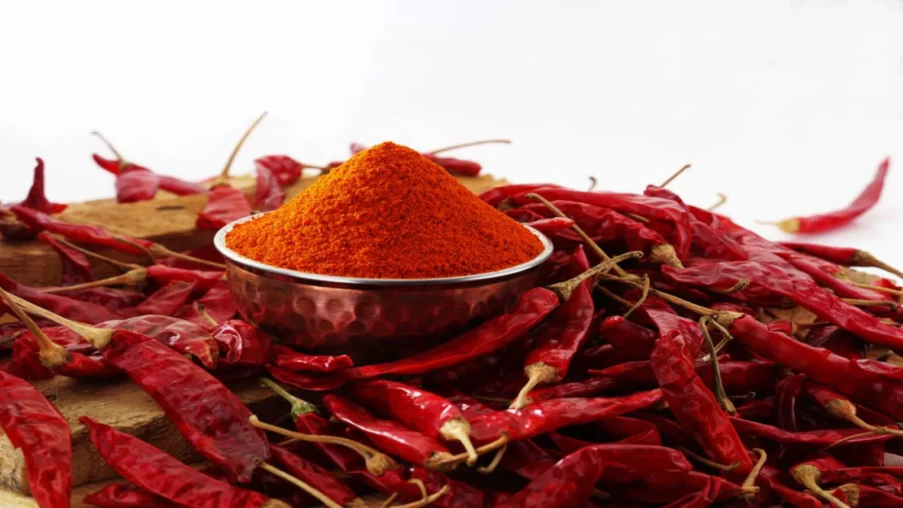Why Indian Red Chillies Are So Popular
India is one of the top countries in the world when it comes to growing and exporting red chillies. Thanks to its perfect climate and variety of soil types, India produces many different kinds of chillies that meet the needs of food lovers, manufacturers, and spice brands around the globe.
Here are some popular types:
- Guntur Chilli (Andhra Pradesh) – Hot and spicy with a deep red color
- Byadgi Chilli (Karnataka) – Less spicy but known for its strong red color, great for sauces and food coloring
- Kashmiri Chilli – Mild, flavorful, and perfect for adding bright red color to dishes
- Dhani and Mundu Chillies – Traditional and often used in pickles and spice powders
Indian chillies are used in everything—from daily cooking and snacks to packaged foods and even cosmetics and medicine.
Why Indian Red Chilli Suppliers Are Trusted Worldwide
India has a strong supply chain of chilli farmers, local traders, and experienced exporters. The top Red Chilli Suppliers in India offer a mix of old-school farming with modern sorting, packaging, and hygiene practices.
Here’s why buyers trust Indian suppliers:
- They get chillies straight from the farms, keeping the quality high
- Use natural sun drying or machines to dry chillies properly
- Sort chillies based on heat, size, and color to match customer needs
- Provide packaging in bulk, vacuum packs, or custom options
- Hold valid export certifications like FSSAI, APEDA, and ISO
So whether you’re running a retail brand, spice company, or food factory, Indian suppliers offer consistent quality and large volumes you can rely on.
How the Red Chilli Export Process Works
If you’re thinking about importing chillies from India, here’s a simple step-by-step breakdown:
- Request a Sample
Start by contacting suppliers and asking for samples. This helps you check the quality, size, spice level, and overall look before placing a big order. - Finalize Price and Paperwork
Once you like the product, talk about prices, packaging needs, and shipping. You’ll also need to handle some paperwork like:
- Proforma Invoice
- Certificate of Origin
- FSSAI and Phytosanitary Certificates
- Bill of Lading
- Packing and Dispatch
Suppliers will pack the chillies as per your choice—either in bulk sacks or smaller sealed packs. Good packaging keeps the chillies fresh during shipping. - Shipping and Customs
Your supplier will work with a shipping company to handle customs and export. Some even take care of door-to-door delivery if needed.
Important Things to Check Before Placing Your Order
To avoid issues like low quality, delays, or shipping problems, make sure to:
- Check if the supplier has valid export certificates
- Ask for past export details or client references
- Confirm if chillies come directly from farms
- Clarify the minimum order size and delivery time
- Ask for lab test reports (for moisture, pesticide, or aflatoxin levels)
Top Red Chilli Suppliers in India will provide all of this openly—they want long-term partnerships, not just one-time deals.
Why Choosing the Right Exporter Really Matters
In the spice world, reliability is everything. You don’t just need cheap prices—you need a supplier who delivers good quality every time, communicates clearly, and helps your business grow.
A professional spice exporter from India can also offer you more products like turmeric, cumin, coriander, and black pepper—all in one shipment.
A good partner helps you:
- Understand market prices and harvest seasons
- Place your orders at the right time
- Handle all export paperwork without stress
Final Thoughts
Indian red chillies are a global favorite—and the demand is growing fast. Whether you need whole dried chillies, crushed flakes, or chilli powder, India can supply it in the quality and quantity you need.
But remember, your success depends on who you work with. The best Red Chilli Suppliers in India don’t just ship products—they support your business by offering consistency, honesty, and great service.
If you’re planning to import red chillies, take time to research, talk to the right supplier, and build a relationship that benefits both sides.





